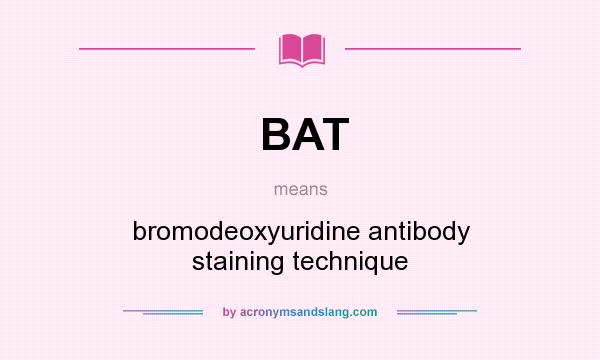What does BAT mean?
BAT means bromodeoxyuridine antibody staining technique
This acronym/slang usually belongs to Undefined category.
What is the abbreviation for bromodeoxyuridine antibody staining technique?
bromodeoxyuridine antibody staining technique can be abbreviated as BAT

|
|
Most popular questions people look for before coming to this page
| Q: A: |
What does BAT stand for? BAT stands for "bromodeoxyuridine antibody staining technique". |
| Q: A: |
How to abbreviate "bromodeoxyuridine antibody staining technique"? "bromodeoxyuridine antibody staining technique" can be abbreviated as BAT. |
| Q: A: |
What is the meaning of BAT abbreviation? The meaning of BAT abbreviation is "bromodeoxyuridine antibody staining technique". |
| Q: A: |
What is BAT abbreviation? One of the definitions of BAT is "bromodeoxyuridine antibody staining technique". |
| Q: A: |
What does BAT mean? BAT as abbreviation means "bromodeoxyuridine antibody staining technique". |
| Q: A: |
What is shorthand of bromodeoxyuridine antibody staining technique? The most common shorthand of "bromodeoxyuridine antibody staining technique" is BAT. |
Abbreviations or Slang with similar meaning
- Ab-L - antibody bound latex beads
- ADCMI - Antibody-Dependent Cell-Mediated Immunity
- ADCML - Antibody-Dependent Cell-Mediated Lysis
- ADMMC - Antibody-Dependent Macrophage-Mediated Cytotoxicity
- ADNLC - Antibody-Dependent Normal Lymphocyte Cytotoxicity
- BrdU - Bromodeoxyuridine
- BrdUrd - Bromodeoxyuridine
- BUDr - Bromodeoxyuridine
- IEST - Immunoenzymatic Staining Technique
- BLI - bromodeoxyuridine labelling index
- FAST - Fluorescent Antibody Staining Technique
- FAS - fluorescent antibody staining
- IGSS - immunogold-silver staining technique
- PLAS - peroxidase-labelled antibody staining
- SAAL - staining of antigen-activated lymphocytes
- SII - staining intensity index
- TMAb - antibody, microsomal antibody
- ACGT - antibody-coated grid technique
- BURD - bromodeoxyuridine
- TAPES - Technique And Practice (or Pressure) Equals Skill. Technique alone is not enough. Application of a new technique in a practice or pressure situation is required to turn the technique into a skill and then improve it.